Mallow

What is mallow and how does it work?
Mallow belongs to the mallow family and is closely related to the hibiscus and hollyhock plants. It contains many valuable ingredients such as mucilage, tannins, flavonoids, vitamin C and minerals. These have an anti-inflammatory, soothing, antibacterial and antioxidant effect. Mallow can therefore help with various complaints, such as
- Skin problems such as eczema, wounds or insect bites
- Respiratory diseases such as coughs, bronchitis or asthma
- Gastrointestinal complaints such as diarrhea, constipation or gastritis
- Urinary tract infections such as cystitis or kidney stones
- Eye infections such as conjunctivitis or styes
How can mallow be used for dogs?
Mallow can be used in various ways for dogs, depending on what ailments are present. The most common forms are
- Tea: Pour a teaspoon of dried mallow flowers or leaves over a cup of boiling water and leave to infuse for 10 minutes. Then strain and leave to cool. The tea can be mixed into the dog's drinking water or given into the mouth with a syringe. The tea can also be used as a poultice or rinse for the skin or eyes.
- Tincture: Fill a glass one third full with fresh or dried mallow flowers or leaves and pour alcohol (e.g. vodka or grain) over them. Seal the jar and leave to infuse in a dark place for two to four weeks. Then strain and pour into a dark bottle. The tincture can be added to the dog's food or drinking water (one to two drops per kilogram of body weight) or applied externally.
- Ointment: Melt 50 grams of beeswax in a water bath and add 100 milliliters of vegetable oil (e.g. olive oil or almond oil). Then stir in a tablespoon of dried mallow flowers or leaves and leave the mixture to simmer for 15 minutes. Then strain and pour into a clean jar. The ointment can be applied to the skin or massaged into the paws.
What are the benefits and disadvantages of mallow for dogs?
Mallow has many benefits for dogs as it is a gentle and natural remedy. It can help with many ailments without causing side effects. It is also easy to obtain and process.
However, there are also some disadvantages of mallow for dogs that you should be aware of. Firstly, mallow can trigger allergic reactions if the dog is hypersensitive to the plant. This can manifest itself as a skin rash, itching, swelling or difficulty breathing. In this case, use should be discontinued immediately and a vet consulted.
On the other hand, mallow can influence the effect of other medications by strengthening or weakening them. This can lead to undesirable interactions. You should therefore always inform your vet if you want to give your dog mallow.
Mallow is a versatile medicinal plant for dogs that can help with many ailments. It is well tolerated and easy to use. However, you should always be aware of possible allergies or interactions.
If you notice any signs of hypersensitivity or poisoning in your dog, you should see your vet immediately. We are not a substitute for a vet, but we try to be as accurate as possible. Every dog reacts differently and we recommend you get a second opinion or consult your vet if in doubt.
Stay healthy and take good care of your four-legged friend!😊
Similar to Mallow
Hibiscus is a genus of plants in the mallow family. There are more than 200 species of hibiscus that grow in the tropics and subtropics of the world. The best known are the marshmallow (Hibiscus...
The common hollyhock (Alcea rosea) adorns many gardens and parks with its tall stems and large, colorful flowers. Originally from the Mediterranean region, it has established itself as a popular...
Marshmallow is a perennial plant from the mallow family that can grow up to 1.5 meters high. It has hairy leaves and pinkish-white flowers. The roots and leaves contain many mucilage substances that...
Shrub poplars are part of the poplar family and are characterized by their unique ability to tremble at the slightest breeze. This phenomenon, combined with the rustling sound of their leaves, gives...



